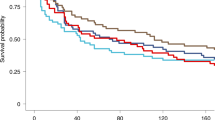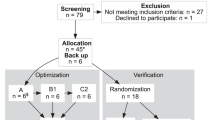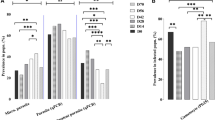Abstract
In areas of stable transmission, clinical immunity to mild malaria is acquired slowly, so it is not usually effective until early adolescence. Life-threatening disease is, however, restricted to a much younger age group, indicating that resistance to the severe clinical consequences of infection is acquired more quickly. Understanding how rapidly immunity develops to severe malaria is essential, as severe malaria should be the primary target of intervention strategies, and predicting the result of interventions that reduce host exposure will require consideration of these dynamics1,2. Severe disease in childhood is less frequent in areas where transmission is the greatest3. One explanation for this is that infants experience increased exposure to infection4,5,6 while they are protected from disease, possibly by maternal antibody. They therefore emerge from this period of clinical protection with considerably more immunity than those who experience lower transmission intensities. Here we use this data3, assuming a period of clinical protection, to estimate the number of prior infections needed to reduce the risk of severe disease to negligible levels. Contrary to expectations, one or two successful infective bites seem to be all that is necessary across a broad range of transmission intensities.
This is a preview of subscription content, access via your institution
Access options
Subscribe to this journal
Receive 12 print issues and online access
$209.00 per year
only $17.42 per issue
Buy this article
- Purchase on Springer Link
- Instant access to full article PDF
Prices may be subject to local taxes which are calculated during checkout



Similar content being viewed by others
References
Anderson, R.M. & May, R.M. in Infectious Diseases of Humans: Dynamics and Control (Oxford University Press, Oxford, 1991).
Baird, J.K. Host age as a determinant of naturally acquired immunity to Plasmodium falciparum. Parasitol. Today 11, 105 (1994).
Snow, R.W. et al. Relation between severe malaria morbidity in children and level of Plasmodium falciparum transmission in Africa. Lancet 349(9066), 1650-1654 ( 1997).
Slutsker, L. et al. Malaria infection in infancy in rural Malawi. Am. J. Trop. Med. Hyg. 55, 71–76 (1996).
Kitua, A.Y. et al. Plasmodium falciparum malaria in the first year of life in an area of intense and perennial transmission. Trop. Med. Int. Health 1, 475–484 ( 1996).
Wagner, G. et al. High incidence of asymptomatic malaria infections in children under 1 year of age in Ghana, detected by multicopy gene polymerase chain reaction. Am. J. Trop. Med. Hyg. 59, 115 –123 (1998).
McGregor, I.A. Malarial immunity: current trends and prospects. Ann. Trop. Med. Parasitol. 81(5), 647–656 (1987).
Trape, J.-F. & Rogier, C. Combating malaria morbidity and mortality by reducing transmission. Parasitol. Today 12, 236–240 (1996).
Marsh, K., Hayes, R.H., Otoo, L., Carson, D.C. & Greenwood, B.M. Antibodies to blood stage antigens of Plasmodium falciparum in rural Gambians and their relation to protection against infection. Trans. R. Soc. Trop. Med. Hyg. 83, 293–303 (1989).
Jeffrey, G.M. Epidemiological significance of repeated infections with homologous and heterologous strains and species of Plasmodium. Bull. WHO 35, 873–882 (1966).
Snow, R.W. et al. Infant parasite rates and immunoglobulin M seroprevalence as a measure of exposure to Plasmodium falciparum during a randomized controlled trial of insecticide-treated bed nets on the Kenyan coast. Am. J. Trop. Med. Hyg. 55, 144–149 (1996).
Bull, P.C. et al. Parasite antigens on the infected red cell surface are targets for naturally acquired immunity to malaria. Nature Med. 4, 358–360 (1998).
Gupta, S., Snow, R.W., Donnelly, C. & Newbold, C.N. Acquired immunity and post-natal clinical protection in childhood cerebral malaria. Proc. R. Soc. 266, 33–38 (1999).
Snow, R.W. et al. The risk of severe malaria among African infants: Direct evidence of clinical protection during early infancy. J. Inf. Dis. 177, 819–822 ( 1998).
Acknowledgements
We are grateful to the Wellcome Trust for financial support.
Author information
Authors and Affiliations
Rights and permissions
About this article
Cite this article
Gupta, S., Snow, R., Donnelly, C. et al. Immunity to non-cerebral severe malaria is acquired after one or two infections. Nat Med 5, 340–343 (1999). https://doi.org/10.1038/6560
Received:
Accepted:
Issue Date:
DOI: https://doi.org/10.1038/6560
This article is cited by
-
Malaria hospitalisation in East Africa: age, phenotype and transmission intensity
BMC Medicine (2022)
-
Direct contact between Plasmodium falciparum and human B-cells in a novel co-culture increases parasite growth and affects B-cell growth
Malaria Journal (2021)
-
Malian adults maintain serologic responses to virulent PfEMP1s amid seasonal patterns of fluctuation
Scientific Reports (2021)
-
Inverse association of falciparum positivity with endemic Burkitt lymphoma is robust in analyses adjusting for pre-enrollment malaria in the EMBLEM case-control study
Infectious Agents and Cancer (2021)
-
Plasmodium falciparum transcription in different clinical presentations of malaria associates with circulation time of infected erythrocytes
Nature Communications (2021)



